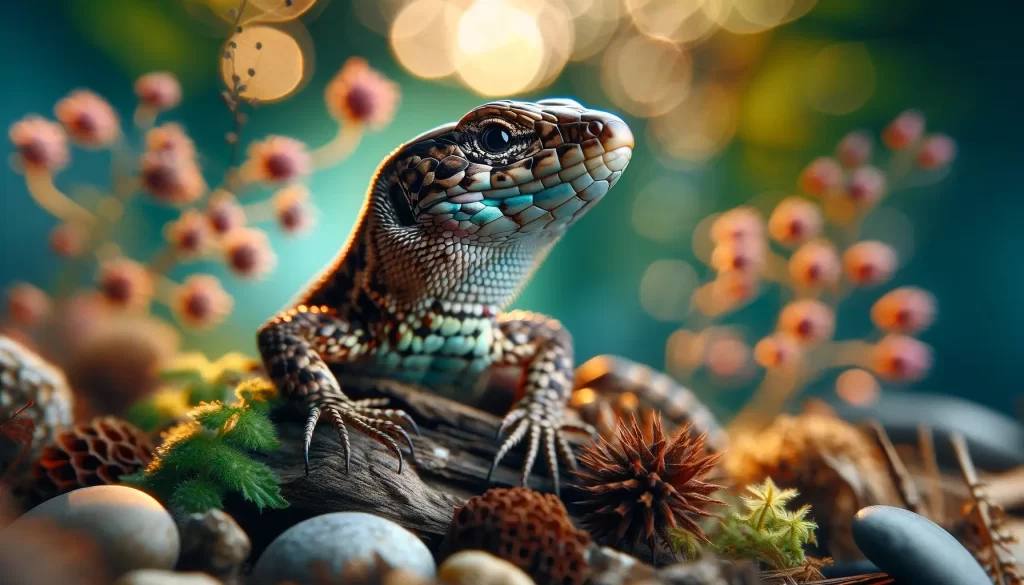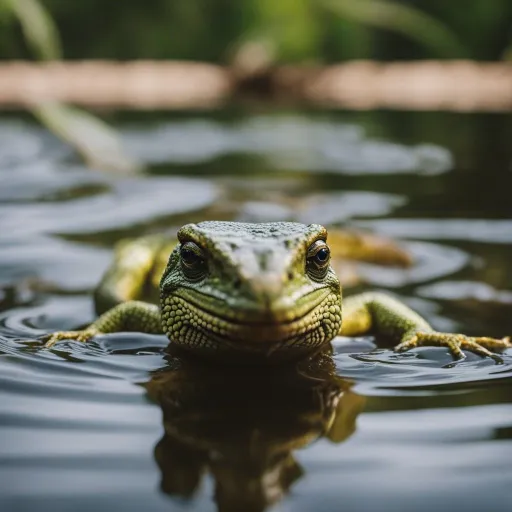
So you’ve come across an Eastern Fence Lizard and now the question lingers in your mind: are they poisonous?
Well, fear not, because we’re here to shed some light on this intriguing topic. Eastern Fence Lizards, also known as Sceloporus undulatus, are fascinating creatures that inhabit various regions of North America.
Despite their menacing appearance, these lizards are not poisonous. However, they do possess a unique defense mechanism that might surprise you.
Let’s uncover the truth about Eastern Fence Lizards and their intriguing traits.
Characteristics of Eastern Fence Lizards
Physical Appearance
Eastern Fence Lizards, also known as Sceloporus undulatus, are medium-sized reptiles native to the eastern United States. They have a distinctive appearance with rough scales and a slender body that can reach up to 7 inches in length. These lizards are typically gray or brown in color, with dark patches and a series of irregular wavy lines running across their backs. Males often have a blue patch on their throat, which they display during courtship or territorial disputes. Overall, their appearance allows them to blend in with their surroundings and provide effective camouflage.
Habitat and Range
Eastern Fence Lizards can be found in a variety of habitats, including forests, grasslands, and open areas with plenty of sun exposure. They prefer areas with loose soil or sandy substrates, as it makes digging burrows easier for them. These lizards are primarily found in the eastern United States, ranging from New York to Florida and as far west as Texas. They are adaptable creatures and can thrive in both rural and suburban environments.
Behavior
Eastern Fence Lizards are diurnal creatures, meaning they are most active during the day. They are agile climbers and can often be spotted basking on trees or fence posts, which is where their common name originates. These lizards are known for their swift movements and can quickly scamper away when they feel threatened. While not considered to be highly aggressive, they may display territorial behavior towards other lizards or predators. Eastern Fence Lizards are capable of running on their hind legs, a behavior that is unique to their species.
Defensive Mechanisms of Eastern Fence Lizards
Camouflage Abilities
One of the primary defensive mechanisms of Eastern Fence Lizards is their excellent camouflage abilities. Their rough scales and mottled pattern allow them to blend seamlessly with their surroundings, making it difficult for predators to spot them. When standing against a tree trunk or fence post, they can be nearly invisible to both humans and other animals. This natural camouflage helps them avoid detection and increases their chances of survival.
Tail Autotomy
Another fascinating defense mechanism displayed by Eastern Fence Lizards is tail autotomy. When threatened or grabbed by a predator, they can voluntarily detach their tail from their body. The detached tail continues to wiggle and distract the predator, allowing the lizard to make a quick escape. Over time, the tail regenerates, although the new tail may not be as long or vibrant as the original. Tail autotomy is a common adaptation found in many lizard species and serves as an effective means of defense.
Biting and Latching
Eastern Fence Lizards also possess strong jaws and sharp teeth, which they can use as a means of defense. When feeling threatened, they may attempt to bite predators or humans with the intention of causing pain or discouraging further aggression. In addition to biting, Eastern Fence Lizards are skilled at latching onto surfaces, allowing them to hold on tightly and prevent predators from easily dislodging them. This behavior, combined with their quick movements, provides them with another layer of defense.
Poisonous Look-alike
While not inherently poisonous themselves, Eastern Fence Lizards can be mistaken for the Western Fence Lizard (Sceloporus occidentalis), which has a similar appearance but possesses venomous qualities. The venomous species, found primarily in the southern parts of the United States, has glandular secretions that contain harmful toxins. It is important to differentiate between the two species to prevent any misconceptions about the Eastern Fence Lizard’s non-poisonous nature.
Diet and Feeding Habits of Eastern Fence Lizards
Insectivores
Eastern Fence Lizards are insectivores, meaning they primarily feed on insects and arthropods. Their diet consists of ants, beetles, grasshoppers, spiders, and other small invertebrates. These lizards are opportunistic feeders and will consume prey items that are readily available in their habitat. Their feeding habits play a crucial role in maintaining ecological balance by regulating insect populations.
Prey Selection
Despite their opportunistic nature, Eastern Fence Lizards display preference in their prey selection. They have been observed to favor larger insects over smaller ones, as they provide greater sustenance. This preference for larger prey allows them to maximize energy intake and reduces the need for constant foraging. By targeting insects such as grasshoppers and beetles, Eastern Fence Lizards contribute to controlling pest populations in their ecosystem.
Foraging Techniques
Eastern Fence Lizards employ active foraging techniques to capture their prey efficiently. They use their keen eyesight and excellent coordination to detect and chase down insects. These lizards can quickly dart towards their prey, utilizing their agile movements and quick reflexes to seize their target. Their ability to climb and cling to various surfaces allows them to navigate their environment effectively and hunt for suitable food sources.
Venom and Poisonous Properties in Reptiles
Venomous vs Non-Venomous Reptiles
It is essential to understand the distinction between venomous and non-venomous reptiles when discussing the Eastern Fence Lizard’s toxicity. Venomous reptiles, such as some snake species, possess venom glands that produce and inject venom into their prey or predators. This venom contains toxic substances that can cause harm or even death. Non-venomous reptiles, like the Eastern Fence Lizard, lack venom glands and do not possess the ability to deliver venom through bites or stings.
Types of Snake Venom
Snake venom can be categorized into various types based on its effect on the body. Hemotoxic venom affects the circulatory system, causing tissue damage, internal bleeding, and disruption of blood clotting. Neurotoxic venom, on the other hand, targets the nervous system and can lead to paralysis or respiratory failure. Understanding the different types of snake venom helps to emphasize that Eastern Fence Lizards, despite their superficial similarities to venomous species, are harmless in terms of venom production.
Poisonous Properties in Lizards
While some lizard species, such as the Gila Monster and Beaded Lizard, possess venom glands and are capable of delivering toxic bites, Eastern Fence Lizards do not possess this trait. Unlike snake venom, lizard venom is relatively rare, with a limited number of lizard species possessing venomous properties. Eastern Fence Lizards, along with many other lizard species, lack the venom glands necessary to produce and deliver toxic substances, making them non-poisonous to humans and other animals.
Understanding Eastern Fence Lizard’s Non-Poisonous Nature
Lack of Venomous Glands
One of the primary reasons Eastern Fence Lizards are not poisonous is due to their lack of venomous glands. These lizards do not possess specialized structures within their bodies capable of producing venom. Instead, they rely on their physical defenses, such as camouflage and tail autotomy, to evade predators. The absence of venomous glands is an inherent characteristic of Eastern Fence Lizards and contributes to their non-poisonous nature.
Absence of Toxic Saliva
In addition to the lack of venomous glands, Eastern Fence Lizards also lack toxic saliva. Unlike venomous reptiles, such as venomous snakes or lizards, these lizards do not have any toxic substances present in their saliva. Their mouths and saliva are not associated with any harmful properties, further solidifying their non-poisonous nature. While they may bite if threatened, the bite itself does not pose any toxic risks to humans or other creatures.
Non-Harmful Skin Secretions
While Eastern Fence Lizards do not produce venom or harmful toxins, they do possess skin secretions that might cause mild irritation to predators. These secretions are not poisonous but serve as a defense mechanism to deter predators. The secretion contains chemicals that make the lizard unpalatable or distasteful, discouraging predators from targeting them in the future. Despite these skin secretions, Eastern Fence Lizards are harmless to humans and pose no significant threats.
Misconceptions About Eastern Fence Lizards
Misidentification With Horned Lizards
One common misconception is the misidentification of Eastern Fence Lizards with Horned Lizards, which are a group of lizard species found in the southwestern United States. Horned Lizards, also known as “horny toads,” have the ability to shoot blood from their eyes as a defense mechanism. This unique adaptation can lead to confusion between the two species, as people may mistakenly associate this ability with Eastern Fence Lizards. However, Eastern Fence Lizards do not possess this characteristic and should not be confused with Horned Lizards.
Confusion With Venomous Lizard Species
Additionally, Eastern Fence Lizards may be mistakenly associated with venomous lizard species, such as the Gila Monster or the Beaded Lizard. Some people may assume that any lizard found in the United States can be venomous, leading to the misconception that Eastern Fence Lizards are also poisonous. It is essential to recognize the differences between these species and educate oneself to avoid unnecessary fear or harm towards Eastern Fence Lizards.
Interactions Between Eastern Fence Lizards and Humans
Human Encounters
Eastern Fence Lizards are often encountered by humans, primarily due to their preference for sunny and open areas. They may be seen basking on fences, rocks, or trees, making them more visible to people in parks, gardens, or suburban areas. While their quick movements and agile behavior might startle some individuals, Eastern Fence Lizards are generally harmless and do not pose any significant threats to humans. It is important to remember that these lizards are wild creatures and should be observed and respected from a distance.
Handling Eastern Fence Lizards
While it is generally recommended to avoid handling Eastern Fence Lizards or any other wild animals, there may be instances where handling is necessary, such as during scientific studies or conservation efforts. If handling is required, it is crucial to do so with care and respect for the lizard’s well-being. It is recommended to wear gloves to protect yourself and prevent any potential harm to the lizard. Proper handling techniques should be followed to minimize stress or injury to both parties involved.
The Importance of Conservation
As with many wildlife species, the conservation of Eastern Fence Lizards is crucial to maintaining ecological balance. These lizards play an important role in controlling insect populations, as they are efficient insect predators. Maintaining suitable habitats, reducing habitat destruction, and raising awareness about the importance of these creatures in our ecosystem are essential steps towards conserving Eastern Fence Lizards and ensuring their continued presence in the wild.
Eastern Fence Lizards in Ecological Balance
Role as Insect Predators
Eastern Fence Lizards provide significant ecological benefits by effectively controlling insect populations. Their diet primarily consists of insects and arthropods, many of which are considered pests. By preying on these pests, Eastern Fence Lizards contribute to the ecological balance of their habitats. The regulation of insect populations helps to minimize agricultural damage, reduce disease transmission, and maintain the health of natural ecosystems.
Relationship with Other Species
Eastern Fence Lizards have complex relationships with other species within their habitat. As predators, they impact insect populations, which can indirectly influence other species within the food web. Additionally, Eastern Fence Lizards may serve as prey for larger predators such as birds, rodents, or snakes. Their place in the food chain highlights their role as an essential component of the ecosystem, where their presence or absence can have cascading effects on the surrounding environment.
Research and Studies on Eastern Fence Lizard’s Toxicity
Previous Research
Over the years, numerous studies have been conducted to understand the toxicity, if any, of Eastern Fence Lizards. These studies have consistently found that Eastern Fence Lizards do not possess venomous glands or produce any venomous or toxic substances. Research has focused on their defensive mechanisms, feeding habits, and ecological roles, shedding light on the fascinating aspects of their biology and dispelling any misconceptions regarding their poisonous nature.
Latest Findings
Recent research on Eastern Fence Lizards has further reinforced the non-poisonous nature of these reptiles. Studies have examined various aspects of their biology, including their genetic makeup, morphology, and behavior. DNA analysis has provided insights into the evolution and genetic relationships of Eastern Fence Lizards, highlighting their unique place within the reptilian world. As our understanding of these lizards continues to grow, it becomes increasingly clear that they are harmless reptiles with fascinating adaptations.
Final Thoughts
In conclusion, Eastern Fence Lizards, despite their superficial resemblance to venomous species and some misconceptions, are not poisonous.
They possess remarkable defensive mechanisms, such as camouflage, tail autotomy, and biting, but lack venomous glands or toxic properties.
Their diet mainly consists of insects, which they efficiently control through active foraging techniques.
Eastern Fence Lizards play an integral role in maintaining ecological balance within their habitats and should be appreciated and conserved for their contributions to the natural world.
By dispelling misconceptions and promoting education about these remarkable reptiles, we can ensure a harmonious coexistence between Eastern Fence Lizards and humans.



